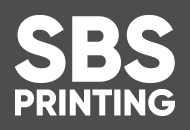Large format banners make a great impression when you go to a trade show or use them in-house. But right now, with so many people working from home, they are also being used as a backdrop for online training or video calls. A well-designed banner makes a striking first impression to customers, develops brand awareness and can make the room that you are working in look professional – even if it is your kitchen! Plus, they are easy to store and transport.
But working with large format graphics can be a little challenging and it is even more important to get the details right when they’re going to be really big. Mistakes are easily spotted!
Read on to find out our 5 top tips for designing large-format banners that make the right impression.
1. Work to scale and keep the resolution high
It can be difficult to work on a large format banner on a small computer screen – so consider scaling down to around a quarter of the size. Make sure your resolution is high, though, so the images are sharp when they are printed. The resolution for large format banners is generally around 150 dpi, but it might be higher if you want it to be sharp from a greater distance. If you need help working out the resolution or scale, talk to the printer before you start.
2. Simplify your message
All good marketing is clear and simple – and this is even more important when it is blown up on a large format print. Make sure you are 100% sure about what you want to say before you start designing your banner and take your time to select images that are aligned with your message. It is a good idea to ask for feedback from people who aren’t close to the design process as you go along. How do they interpret your text or images? Are they clear what product or service you provide, who your target customer is and what benefits they will get from working with you or buying your product?
3. Important messages should be eye-height
When you decide where to put the text and images on your banner, consider the height from which your customer will view it – will they be standing up or sitting down? The main message should be eye-height, and any detailed drawings shouldn’t be too high or low, or they will get lost. Make sure your design isn’t too busy. White space around your main message will make it stand out and be more memorable.
4. Colours and fonts
You should always use your brand colours and fonts wherever possible because consistent branding is more memorable. When selecting colours, it’s a good idea to use “pantone” colours. This is a universal language that gives each colour a #number and means the colour you select on your computer will be the same one used by the printer. If you don’t have a brand font, select one that isn’t too delicate, as “fancy” letters viewed from a distance can be difficult to read.
5. File format
If you have access to Illustrator or InDesign, use that to create your banner as you’ll be able to save the file as a vector file (.eps or .ai) which are easier to shrink or enlarge without pixelation. Vector files are also smaller, and easier to share. If you are unsure, ask for advice from your printer about the best file format and package to use before you start so when you’re finished you can get it printed quickly.
If you need help designing or printing large format graphics and roll-up banners, contact SBS Printers. We can print any size, even custom dimensions, and our machines produce the top-quality prints. We would love to help!
